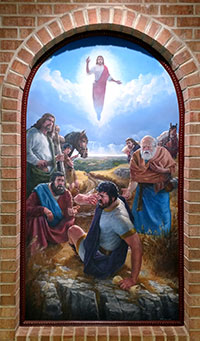 GREENSBORO — An original painting depicting the Conversion of St. Paul was installed recently at St. Paul the Apostle Church.
GREENSBORO — An original painting depicting the Conversion of St. Paul was installed recently at St. Paul the Apostle Church.
The 72-inch-by-40-inch acrylic ink on wood panel work depicts the key moment when Jesus appears before Saul as he heads towards Damascus in order to persecute the followers of Christ. Greensboro artist and illustrator Erik Shea Saalmuller created the piece, working 400 hours over four months in consultation with Father Joseph Mack, pastor.
Based on research, Saalmuller created the composition to include the following points:
- At the time of his conversion, Saul was less than 30 years old and held a position of authority among older Pharisees. His conversion occurred en route to Damascus, located in modern-day Syria. The landscape is primarily plains and flat stretches of land, with mountains and hills breaking up the terrain
- Most Renaissance paintings, in which Saul is shown being tossed from his horse as Jesus appears before him, were probably inaccurate. As a devout Jew, Saul would have kept to the traditions of his forefathers by praying three times a day: morning, noon and evening. In his own recollection recounted in the Acts of the Apostles, St. Paul said he saw Jesus appear before him at midday, which would have coincided with the time of his prayers. Even if he had a horse to help ease the burden of traveling the long distance from Jerusalem to Damascus, he would not have been mounted on horseback at the time Jesus appeared. This led Saalmuller to show St. Paul as if he fell while walking the path, rather than depicting the horse in a chaotic bucking motion.
 -In the Bible passage, Jesus appears before Saul on the road to Damascus, but the other men accompanying Saul on his journey could only hear, not see, Jesus. Since the men could not see Jesus, they would naturally either look around, or reach out to help the now-blind Saul, who to their minds was being afflicted by something far beyond their understanding.
-In the Bible passage, Jesus appears before Saul on the road to Damascus, but the other men accompanying Saul on his journey could only hear, not see, Jesus. Since the men could not see Jesus, they would naturally either look around, or reach out to help the now-blind Saul, who to their minds was being afflicted by something far beyond their understanding.


